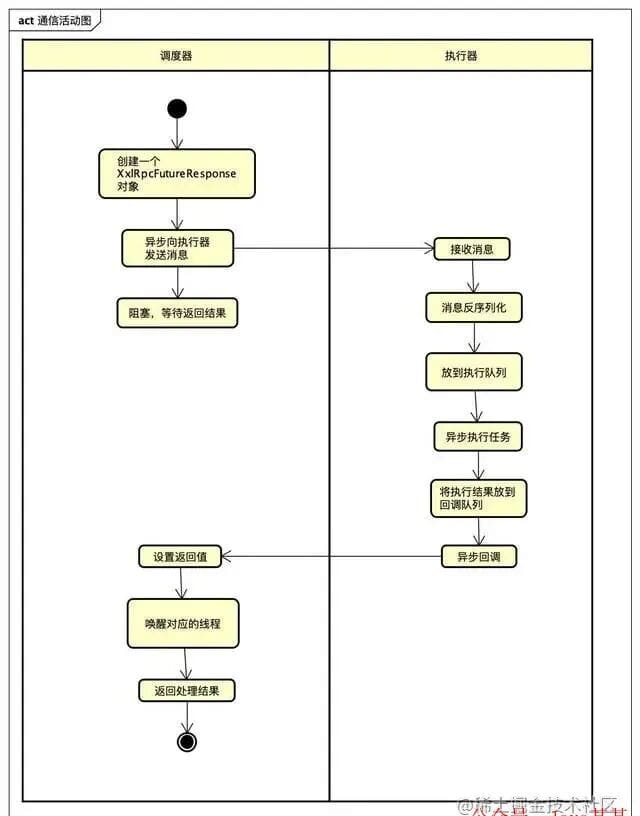Impressive Architecture Designs in XXL-Job

Overview
Date: 2025-10-23 07:15 — Location: Guangdong
The design of `xxl-job`’s communication layer is a masterclass in combining Netty and multithreading. It demonstrates an ingenious use of asynchronous processing and dynamic proxies to achieve both clarity and high performance.

---
Table of Contents
---
1. Introduction to the Communication Layer
`xxl-job` uses Netty HTTP as its default communication protocol.
Although it supports Mina, Jetty, and Netty TCP, the implementation is hardcoded to Netty HTTP.
---
2. Overall Communication Process
Taking the scenario of the scheduler notifying the executor to run a task as an example, here is the corresponding activity diagram:

---
3. Impressive Design
The design seamlessly applies Netty and multithreading principles. Key features include:
---
3.1 Dynamic Proxy Pattern for Transparent Communication
- Interfaces:
- ExecutorBiz — heartbeat, pause, trigger execution.
- AdminBiz — callback, registration, deregistration.
- These interfaces contain no direct communication code.
- The `XxlRpcReferenceBean.getObject()` method generates proxies which handle remote communication transparently.
---
3.2 Fully Asynchronous Processing
On Receiving Messages:
- Executor deserializes the request.
- Task info is stored in a `LinkedBlockingQueue`.
- An async thread executes tasks from this queue.
On Sending Results:
- Results are stored in a callback thread queue.
- Returned to scheduler asynchronously.
Benefits:
- Reduces Netty worker thread blocking.
- Improves system throughput.
---
3.3 Asynchronous Wrapped as Synchronous API
Example from scheduler’s `XxlJobTrigger`:
// Example snippet (simplified)
public void triggerJob(...) {
executorBiz.run(taskInfo); // Code appears synchronous
}Result: Clear API usage despite asynchronous internals.
---
3.4 Synchronous Result Retrieval via Dynamic Proxy
public static ReturnT runExecutor(TriggerParam triggerParam, String address) {
ReturnT runResult = null;
try {
ExecutorBiz executorBiz = XxlJobScheduler.getExecutorBiz(address);
// Executes asynchronously but returns result synchronously
runResult = executorBiz.run(triggerParam);
} catch (Exception e) {
logger.error(">>>>>>>>>>> xxl-job trigger error, please check if the executor[{}] is running.", address, e);
runResult = new ReturnT(ReturnT.FAIL_CODE, ThrowableUtil.toString(e));
}
StringBuffer runResultSB = new StringBuffer(I18nUtil.getString("jobconf_trigger_run") + ":");
runResultSB.append("address:").append(address);
runResultSB.append("code:").append(runResult.getCode());
runResultSB.append("msg:").append(runResult.getMsg());
runResult.setMsg(runResultSB.toString());
return runResult;
}The corresponding dynamic proxy logic:
if (CallType.SYNC == callType) {
XxlRpcFutureResponse futureResponse = new XxlRpcFutureResponse(invokerFactory, xxlRpcRequest, null);
try {
client.asyncSend(finalAddress, xxlRpcRequest);
XxlRpcResponse xxlRpcResponse = futureResponse.get(timeout, TimeUnit.MILLISECONDS);
if (xxlRpcResponse.getErrorMsg() != null) {
throw new XxlRpcException(xxlRpcResponse.getErrorMsg());
}
return xxlRpcResponse.getResult();
} catch (Exception e) {
logger.info(">>>>>>>>>>> xxl-rpc, invoke error, address:{}, XxlRpcRequest{}", finalAddress, xxlRpcRequest);
throw (e instanceof XxlRpcException) ? e : new XxlRpcException(e);
} finally {
futureResponse.removeInvokerFuture();
}
}---
3.5 Thread Blocking and Wake-Up Mechanism
Class: `XxlRpcFutureResponse`
- Blocks calling thread until result is available.
- Wakes thread when remote response arrives.
public void setResponse(XxlRpcResponse response) {
this.response = response;
synchronized (lock) {
done = true;
lock.notifyAll();
}
}
@Override
public XxlRpcResponse get(long timeout, TimeUnit unit) throws InterruptedException, ExecutionException, TimeoutException {
if (!done) {
synchronized (lock) {
if (timeout < 0) {
lock.wait();
} else {
long timeoutMillis = (TimeUnit.MILLISECONDS == unit) ? timeout : TimeUnit.MILLISECONDS.convert(timeout, unit);
lock.wait(timeoutMillis);
}
}
}
if (!done) {
throw new XxlRpcException("xxl-rpc, request timeout at:" + System.currentTimeMillis() + ", request:" + request);
}
return response;
}---
3.6 Unique Request ID Mapping
How does the scheduler know which thread to wake up?
- Each RPC request generates a UUID request ID.
- The response handler uses this ID to find the correct `XxlRpcFutureResponse`.
public void notifyInvokerFuture(String requestId, final XxlRpcResponse xxlRpcResponse) {
final XxlRpcFutureResponse futureResponse = futureResponsePool.get(requestId);
if (futureResponse == null) return;
if (futureResponse.getInvokeCallback() != null) {
...
}
}---
3.7 Asynchronous Callback vs Synchronous Response
try {
executeResponseCallback(new Runnable() {
@Override
public void run() {
if (xxlRpcResponse.getErrorMsg() != null) {
futureResponse.getInvokeCallback().onFailure(new XxlRpcException(xxlRpcResponse.getErrorMsg()));
} else {
futureResponse.getInvokeCallback().onSuccess(xxlRpcResponse.getResult());
}
}
});
} catch (Exception e) {
logger.error(e.getMessage(), e);
}
} else {
// Wake up waiting threads
futureResponse.setResponse(xxlRpcResponse);
}
futureResponsePool.remove(requestId);

---
Key Takeaways
- Clear Separation of Concerns: Communication hidden behind proxies.
- High Throughput: Async queues minimize Netty thread blocking.
- Request-Response Mapping: UUID request IDs ensure correct wake-up.
- Flexible Pattern: Supports both sync and async API styles.
---
Related Note: Content Automation Parallel
Just like `xxl-job` synchronizes async communication efficiently, global content distribution platforms require robust task coordination.
For example, AiToEarn — an open-source AI content monetization platform — connects:
- AI-powered content generation
- Multi-platform publishing (Douyin, Kwai, WeChat, Bilibili, YouTube, etc.)
- Analytics and AI model ranking (AI模型排名)
It uses task mappings and response synchronization patterns similar to `xxl-job`’s RPC handling, ensuring each publishing job triggers the correct process and pipeline. This guarantees efficiency and scalability for creators.
📘 Explore:
---
If you'd like, I can create a visual flow diagram showing exactly how `xxl-job`'s asynchronous-to-synchronous RPC transformation works, making it even clearer at a glance.
Would you like me to add that diagram?




